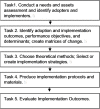Implementation Mapping: Using Intervention Mapping to Develop Implementation Strategies
- PMID: 31275915
- PMCID: PMC6592155
- DOI: 10.3389/fpubh.2019.00158
Implementation Mapping: Using Intervention Mapping to Develop Implementation Strategies
Abstract
Background: The ultimate impact of a health innovation depends not only on its effectiveness but also on its reach in the population and the extent to which it is implemented with high levels of completeness and fidelity. Implementation science has emerged as the potential solution to the failure to translate evidence from research into effective practice and policy evident in many fields. Implementation scientists have developed many frameworks, theories and models, which describe implementation determinants, processes, or outcomes; yet, there is little guidance about how these can inform the development or selection of implementation strategies (methods or techniques used to improve adoption, implementation, sustainment, and scale-up of interventions) (1, 2). To move the implementation science field forward and to provide a practical tool to apply the knowledge in this field, we describe a systematic process for planning or selecting implementation strategies: Implementation Mapping. Methods: Implementation Mapping is based on Intervention Mapping (a six-step protocol that guides the design of multi-level health promotion interventions and implementation strategies) and expands on Intervention Mapping step 5. It includes insights from both the implementation science field and Intervention Mapping. Implementation Mapping involves five tasks: (1) conduct an implementation needs assessment and identify program adopters and implementers; (2) state adoption and implementation outcomes and performance objectives, identify determinants, and create matrices of change objectives; (3) choose theoretical methods (mechanisms of change) and select or design implementation strategies; (4) produce implementation protocols and materials; and (5) evaluate implementation outcomes. The tasks are iterative with the planner circling back to previous steps throughout this process to ensure all adopters and implementers, outcomes, determinants, and objectives are addressed. Discussion: Implementation Mapping provides a systematic process for developing strategies to improve the adoption, implementation, and maintenance of evidence-based interventions in real-world settings.
Keywords: adaptation; adoption; dissemination; health promotion; implementation; implementation strategies; intervention mapping; mechanisms of change.
Figures
References
-
- Brownson RC, Tabak RG, Stamatakis KA, Glanz A. Implementation, dissemination, and diffusion of public health interventions. In: Glanz K, Rimer BK, Viswanath K, editors. Health Behavior: Theory, Research, and Practice 5th ed. San Francisco, CA: John Wiley & Sons; (2015). p. 301–26.
Grants and funding
LinkOut - more resources
Full Text Sources
Medical



